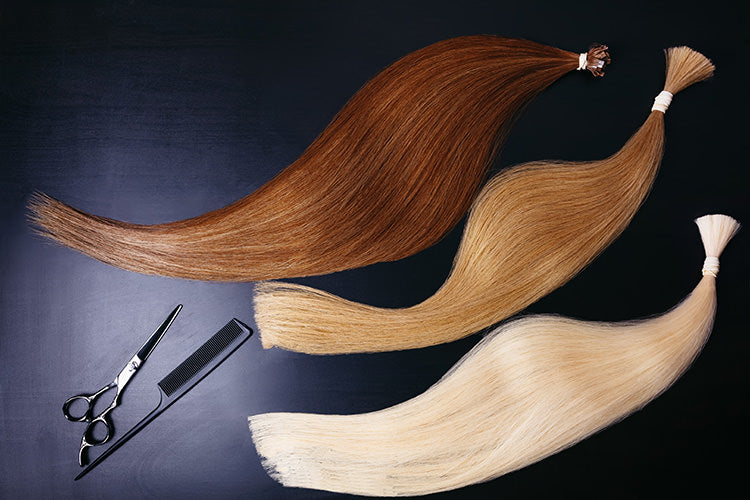
Thin Hair and Fine Hair Can Be a Challenge

Volumizing thin hair takes more than body building shampoo and a good haircut and style.
Fine hair can be a challenge for many hairdressers, as it can be delicate, easily damaged, and may require special techniques and products to keep it looking healthy and full. In this article, we will explore some of the key things that you should know about fine hair, including its unique characteristics, common styling and cutting techniques, and tips for keeping fine hair looking its best.
Find out how you can make hair look fabulous
First, it's important to understand the unique characteristics of fine hair. Finer hair is typically thinner in diameter than other hair types, which can make it appear limp or flat. It also tends to be more delicate and prone to breakage, so it requires gentle handling and special care. Additionally, fine strands may be more susceptible to damage from heat styling tools, chemical treatments, and environmental factors like sun exposure and pollution.
When it comes to styling thin hair, there are a few key techniques that hairdressers should keep in mind. One important technique is to avoid using heavy or oily products that can weigh your hair down and make it appear greasy or limp. Fine hair needs lightweight products like mousses, sprays, or serums that can add volume and texture without weighing down the hair. Another important styling technique is to use a round brush to lift your hair when blow-drying fine hair, as this can help create volume and body. Finally, you should avoid using high heat on your clients when styling thin hair, as this can cause damage and breakage. Instead, use low to medium heat settings and always use a heat protectant spray before applying heat.
In terms of cutting fine hair, there are a few key techniques that can help create the illusion of fuller, thicker hair. One technique is to incorporate layers into the haircut, as this can add movement and texture to fine hair. However, it's important to avoid over-layering the hair, as this can make it appear even thinner and more limp. Another important cutting technique is to avoid using blunt cuts or heavy lines, as these can weigh down thin hair and make it appear flat. Instead, opt for softer, more textured cuts that can add volume and dimension to the hair.
Hair Care for Fine Hair
Finally, when it comes to keeping fine hair looking its best, there are a few key tips that you should share with your clients. One important tip is to avoid washing fine hair too frequently, as this can strip the hair of its natural oils and make it appear dry and brittle. Instead, recommend that clients wash their hair every other day or every few days, and use a gentle, sulfate-free shampoo formulated for fine hair that won't dry out the hair. Another important tip is to avoid brushing or combing wet hair, as this can cause breakage and damage. Instead, recommend that clients use a wide-tooth comb or detangling brush to gently work out any knots or tangles.
Fine hair can be a challenge, but with the right techniques and products, it's possible to create beautiful, voluminous styles that showcase the unique characteristics of this hair type. By understanding the unique characteristics of fine hair, using the right styling and cutting techniques, and sharing key tips with clients, you can help your clients look and feel their best, no matter what their hair type may be.
Add Hair Extensions for Fine and Thin Hair Best Hairstyles

Best hairstyles for fine and thin hair
Hand-tied hair extensions can be a great option for fine or thin hair clients who are looking to add volume, length, or fullness to their hair. As a hairdresser, it's important to understand the different types of hair extensions available, as well as how to properly install and maintain them for your clients. In this article, we will explore some of the ways that you can use hair extensions to enhance the look of thin hair.
One of the most popular types of hair extensions is clip-in extensions. Clip-in extensions are easy to install and remove, making them a great choice for clients who want to add temporary volume or length to their hair for a special occasion or event. To install clip-in extensions, start by sectioning off the hair and backcombing the roots to create a secure base for the clips. Then, clip the extensions onto the roots, working from the bottom up, and blend the natural hair with the extensions using a brush or comb.
Another type of hair extensions that you can use for clients with thin hair is tape-in extensions. Tape-in extensions are semi-permanent and can last for several weeks to several months, depending on how well they are maintained. To install tape-in extensions, start by sectioning off the hair and applying the tape-in extensions to the roots using a special adhesive. Then, blend the natural hair with the extensions using a brush or comb, and style as desired.
Another option for clients with thin hair is flex-tip extensions. Nano bead extensions are applied by threading small beads onto the natural hair and then securing the flex-tip extensions to the beads using a special tool. Micro bead extensions are a good choice for clients who want a longer-lasting solution than clip-in extensions but don't want to commit to the semi-permanent nature of tape-in extensions.

When working with clients with thin hair, it's important to choose the right type of hair extensions for their specific needs. You should also take care to install the extensions properly, as incorrect installation can damage the natural hair and make the problem worse. Additionally, it's important to educate clients on how to properly care for their hair extensions to ensure they last as long as possible.
LEARN FROM A PROFESSIONAL! HERE IS ALL THE INFORMATION YOU NEED FOR HAND-TIED, TAPE-INS, AND FLEX-TIP EXTENSIONS!
No more flat hair!
In addition to using hair extensions, you can also use styling techniques to enhance the look of thin strands. One popular technique is to add layers to the haircut, as this can make hair appear fuller. Another technique is to use volumizing products like mousses or sprays to add texture and body to the hair. Finally, you can use heat styling tools like curling irons or straighteners to create volume and movement in the hair.
Hair extensions are a great solution for clients with thin or hair who are looking to add volume, length, or fullness to their hair. As a hairdresser, it's important to understand the different types of hair extensions available, as well as how to properly install and maintain them for your clients. By using the right techniques and products, you can help their clients achieve the full, voluminous hair they've always wanted.
Some of the best hairstyles for thin hair look more voluminous with that addition of extensions

Adding extension services to your salon can have a number of benefits for clients with thin hair. First and foremost, hair extensions can be an excellent solution for clients who want to add volume, length, or fullness to their hair. By offering extension services, you can help these clients achieve the look they want and boost their confidence and self-esteem.
Another benefit of offering extension services is that it can help you attract new clients and retain existing ones. Many people are interested in trying hair extensions but may not know where to go or who to trust. By offering high-quality extension services, you can differentiate your salon from the competition and attract clients who are specifically seeking out this type of service. Additionally, offering extension services can help you retain existing clients who may be tempted to try another salon that offers this service if you don't.
Offering extension services can also be a lucrative source of revenue for your salon. Hair extensions are typically priced based on the type of extension, the length, and the amount of hair needed, which means that they can be quite profitable. By offering extension services, you can increase your average ticket price and boost your overall revenue.
Finally, offering hair extensions services can be a way to stay up-to-date with the latest trends and techniques in the beauty industry. Hair extensions are a constantly evolving field, and by offering these services, you can stay on top of the latest trends and techniques, which can help you attract even more clients and improve your overall reputation. Adding extension services to your salon can be a valuable way to serve clients with fine hair, attract new clients, boost your revenue, and stay up-to-date with the latest trends and techniques in the beauty industry. By offering high-quality extension services and educating your clients on how to properly care for their extensions, you can help your clients achieve the full, voluminous hair they desire and keep them coming back to your salon for all their hair care needs.
The absolute best method for thin, fine hair is Flex-Tip Nano extensions. They are the easiest to hide in fine hair and will not damage delicate strands. Learn for free here.



